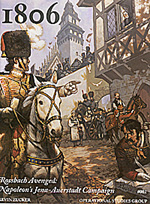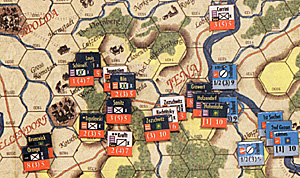 Game Designer: Kevin Zucker
Game Designer: Kevin Zucker
Game Graphics: Joseph Youst (map), Jenny Reilly (box design), Rodger MacGowan (counters).
OB Research: John Wladis, Charles Dunn
Game Development: Dave Collins
Number of Players: Two players or two teams
Complexity Level: Moderately high; combat system is not complex, but the command system takes time to master.
Scale: Operational; players maneuver corps consisting of several infantry
divisions and cavalry brigades on a map where hexes are 1.1 mile across and there are three day
turns plus one night turn per 24-hour period.
Maps & Playing Pieces: Two 22-inch-by-34 inch mapsheets and 280 1/2-inch counters.
Rules: Uses the Six Days of Glory system. Only 17 pages of the 28-page softbound rulebook are actual game rules. Included are extensive historical commentary and players' notes.
Scenarios: Nine, from meeting
engagement to full campaign.
Publisher: Operational Studies Group
Publication Date: 1998
List Price: $48.00
Summary:
1806 is a simulation of Napoleon's
victorious campaign over Prussia's
vaunted army. Experienced gamers will
appreciate the historical detail and
challenging command system of 1806. The
game also uses cavalry in a novel way,
allowing them to screen their army and
delay an opposing force.
The 1806 campaign was very onesided. Napoleon's Grande Armee having just defeated the Austrians and Russians at Ulm and Austerlitz the prior year in its first campaign, dominated the Prussian army which basically fought very much like it did under Frederick the Great fifty years previously.
Although the French player has a definite advantage, the Prussian player can win. He cannot defeat the French by moving forward and engaging in a straight up fight. Instead, the indirect approach is recommended, being careful to not reveal his chosen strategy too soon.
Units are placed on the map upside down to hide their exact identity and strengths. Many of the 280 counters provided are informational markers such as pontoon bridges or out of command status, while others are step reduction indicators used to replace a unit as it loses strength. Thus, the French player is actually only maneuvering a maximum of 16 infantry divisions, one division of light troops, 15 cavalry divisions or brigades, and eight corps leaders plus one army leader (Napoleon), while the Prussian player controls 15 infantry divisions, seven divisions of light troops, 11 cavalry brigades, and seven corps or army leaders. There are also numerous light cavalry vedettes which help screen an army by delaying enemy units or channeling their advance. However, these vedettes are placed on the map by removing their larger parent unit: For example, Guyot's French cavalry brigade can be replaced with three such vedette units.
The nine scenarios all employ historical set-up positions of the armies on a given date. Some scenarios, by beginning earlier than they did historically give the Prussian player the benefit of insights not available to his historical counterpart. Three of the scenarios represent the set-piece battles of Saalfeld (10 October, 1806), Jena and Auerstddt (14 October). Some scenarios last only one day, which, at about twenty minutes playing time per turn, means you can finish a game in about two hours.
Each player is provided with a quick set-up order-of-battle display sheet which includes the combat table for easy reference. The rulebook includes eight pages of historical notes, including a map, footnotes, and bibliography. There are also extensive player's notes
The game is divided into several turns per day, each of which is subdivided into so-called player turns. The moving player spends command points, makes initiative rolls, moves those units that are able to move and fight, then rolls to see if out of command units can move, and finally resolves combat. The other player then performs these same steps.
The command system is the heart of the game. The highest value leaders put some units in command, up to the limit of command points they have. Lower value leaders can roll to see if they are able to move on their own, and individual units can roll to see if they are able to move independently (only if the unit cannot trace command to a leader).
There are a few ambiguities in the rules (the rules say that villages provide a column shift in combat, the Terrain Effects Chart says they do not) but most of these are easily resolved. The counters are colorful and the maps are beautifully rendered. The pace of the game is relatively swift, and the "hidden" (upside down) units provide a form of limited intelligence.
This is a relatively fun game. The scale is rather similar to Clash of Arms' Jena (reviewed in Napoleon #9). The game rules and information provided in the scenarios will discourage the Prussian player from repeating the overconfident moves of the historical Prussian army commanders Brunswick and Hohenlohe. The possibilities for maneuver and contact at unexpected places should make for an interesting experience for both players. The Prussians can win (it happened the first time we played!) and the command system works well at simulating the historical limitations of movement and combat.
Battle of Jena
Lannes' V French corps attacks Hohenlohe's Prussian III Corps, supported by elements of Zezschwitz's II Corps near the town of Jena on 13 October, 1806 in OSG's board game 1806 Rossbach Avenged.

Back to Table of Contents -- Napoleon #13
Back to Napoleon List of Issues
Back to MagWeb Master Magazine List
© Copyright 1998 by Napoleon LLC.
This article appears in MagWeb (Magazine Web) on the Internet World Wide Web.
The full text and graphics from other military history magazines and gaming magazines are available at http://www.magweb.com
Order Napoleon magazine direct